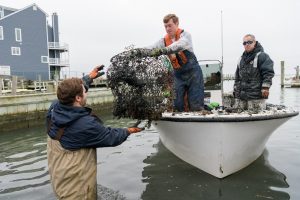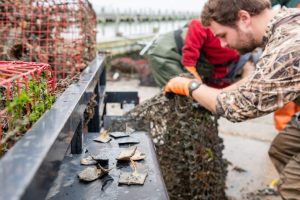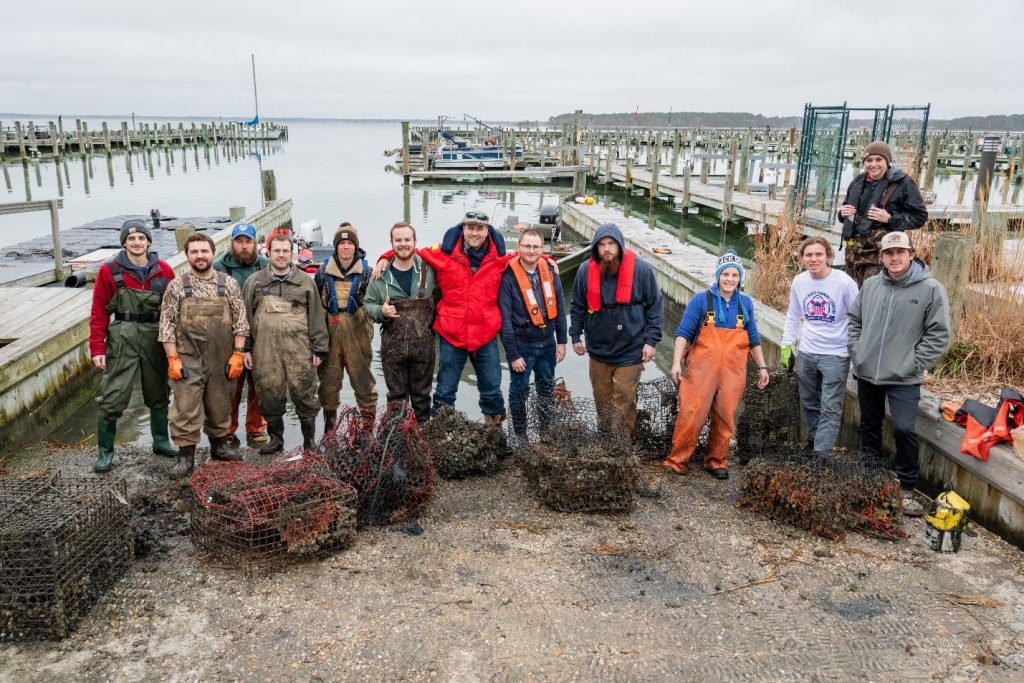
Facebook Twitter Instagram YouTube RSS Feed
Written on: December 9th, 2020 in Outreach
Guest Writer: Kate Fleming, Delaware Sea Grant
When crab pots* are lost or abandoned at sea, they remain in the water, free to continue to capture blue crabs as they are designed to do. They can also capture other animals like diamondback terrapin and summer flounder. Since derelict crab pots are not tended by anyone, the animals that become trapped inside will eventually die. As such, these forgotten pots can lead to continued and needless mortality in our ecosystem in a process called ghost fishing.
Gear loss and abandonment is fairly common in pot-based fisheries. That’s because pots are designed to be placed in the water and left alone for days at a time before being checked on. This comes with some inherent risk for accidental loss and sometimes obstacles can come up that hinder a timely return.
Here in Delaware, blue crabbing is an important commercial industry. It is also a popular recreational past-time that leads to the capture of over 1 million blue crabs each year. Could it be that we have ghost crab pots scattered across the bottom of Delaware’s Inland Bays, where only recreational crabbing takes place? Based on the work I have been doing with University of Delaware Professor, Dr. Art Trembanis, I can say with confidence that the answer is yes, yes we do.

Grant Otto (graduate student in the Coastal Sediments, Hydrodynamics, and Engineering Lab) and Chris Petrone Delaware Sea Grant Extension Director) hand off a derelict crab pot (Evan Krape UD)
This shouldn’t be particularly surprising given the ubiquitous nature of this type of marine debris. However, the shallow murky waters of our Inland Bays offer an effective hiding place. Last winter** we used a commercial-grade side scan sonar to document over 560 derelict crab pots submerged beneath the surface of just under 250 acres of Rehoboth Bay. This represents some of the highest densities of derelict crab pots that have been estimated in Chesapeake Bay, which supports one of the largest blue crabbing fisheries in the nation. We followed our surveys up with a pilot removal effort. We recovered about 100 derelict crab pots in just a couple days. (Read more about our pilot removal project here!).
Today our project team has grown to include University of Delaware graduate student Jen Repp. It also includes Delaware Sea Grant’s Fisheries and Aquaculture Specialist, Dr. Ed Hale. Our sights are now set on Indian River Bay. Jen and Art are initiating side-scan sonar surveys any day now. Plus, I am in the thick of planning Derelict Crab Pot Round-Ups across three days this January and/or February 2021. The whims of the weather will determine the specific dates!
Compared to last year’s pilot project, we plan to quadruple our survey area. We will be removing 10 times the number of derelict crab pots over the next two years, aided by volunteers with boats that are willing to wield a grappling hook and help us on the water. We’ll be staging out of Holts Landing State Park and keeping our fingers crossed for flat calm seas and the balmiest of winter temperatures!
Interested in helping out? We are targeting volunteers that can bring and crew their own boats. Click here for more information and to register a team, or contact me at kfleming@udel.edu with any questions!
If you don’t have a boat but would still like to contribute, there are a couple other volunteer opportunities that will likely come up with this project:
– We will be giving a subset of our recovered pots to the Partnership for Delaware Estuary (PDE) to be repurposed in a living shoreline experiment. Following the removal, the Center for Inland Bays (CIB) will be coordinating volunteers to transport these pots to Wilmington, DE where PDE is located. Interested volunteers can contact CIB Volunteer Coordinator, Nivette Perez-Perez at nperezperez@inlandbays.org.
– I will likely be looking for volunteer assistance to refurbish any remaining crab pots this spring or summer so that they can be reused for education and outreach. If that sounds like fun (I think it does), please reach out (kfleming@udel.edu) and I’ll get you on my list.
One of the most common questions I get when I talk about derelict crab pots in Delaware’s recreational blue crab fishery is: Why? Why would a recreational crabber abandon their pots? Our work doesn’t actually focus on answering that question. But, I often like to point out that DNREC-Enforcement has an existing program to curb crab pot abandonment in our state. The program issues notices and then seizes pots that have not been tended within three days as is required in Delaware. They actually let me collect data through this program. It has been an outstanding opportunity to learn about recreational crab pot abandonment rates. I’ve also learned a lot about Turtle Bycatch Reduction Device (TBRD) compliance (a little more on TBRD’s below).
With that program in place, I prefer to ponder the issue of accidental pot loss. I suspect it is an important contributor to the presence of derelict crab pots in our Inland Bays. If gear is rigged with old, degrading line it can be more susceptible to breakage by rough weather or boat propellers. Likewise, buoys assembled from hollow materials are more likely to fill up with water and sink if punctured. We have recovered quite a few derelict crab pots that had bleach bottle and bumper “floats” still attached that were no longer doing their jobs.
These are accidents of course. But, I do think there are things that recreational crabbers and boaters can do to minimize the potential to lose a pot. These are things like:
-Use those white foam bullet floats in lieu of bleach bottles or bumpers
-Change out your lines each year
-Use line that sinks
-Keep your eye on the weather forecast before you set your pots
-Update your tending plan if it looks like a storm is coming or you have to go out of town
Likewise, boaters should:
-Stay vigilant for buoys on the water
-Wear polarized sunglasses to make spotting them a little easier
-Slow down and give buoys plenty of berth to avoid a line strike. The pot lines can be hard to see and are often times longer than you think.

Scutes provide evidence of diamondback terrapin mortality inside derelict crab pots (Evan Krape, UD)
Then there are things you can do to minimize impacts in the event that a pot does go missing. The first is to simply remember that the limit for recreational crabbers in Delaware is two pots per person. We know that some amount of pot loss is unavoidable. Therefore, keeping the number of pots fished to the required limits can reduce the overall quantity that end up on the Missing in Action list.
In Delaware, crabbers are required to install Turtle Bycatch Reduction Devices on all funnel entrances of a recreational crab pot. They help keep diamondback terrapins from getting inside the pots, where they will eventually drown. For more information on TBRD’s, or Terrapin Excluder Devices as they are often called, check out DNREC’s TBRD Pamphlet.
Cull rings are not actually required in Delaware. However, they have been shown to allow sublegal crabs (crabs you wouldn’t be able to keep anyway) and other small organisms to escape. They are required in some of our neighboring states, so should be fairly easy to find if you want to go the extra mile. A juvenile blue crab will thank you.
I want to wrap up by offering some acknowledgement and thanks to those that have helped us with our past and current projects. It truly takes a village.
Delaware Sea Grant provided the seed funding to get our initial side-scan sonar surveys going to confirm the prevalence of derelict crab pots in Rehoboth Bay. We received additional funding from the University of Delaware School of Marine Science and Policy. Subsequently, we have received funding from Delaware Coastal Programs and the NOAA Marine Debris Program.
Delaware Coastal Programs and several sections within the Delaware Division of Fish and Wildlife (Enforcement, Fisheries, and Wildlife) have provided support to this project. They have provided a boat and labor on clean-up days, permitting support, technical assistance, and more. Rehoboth Bay Marina allowed us to stage our removal at their private boat ramp. This was invaluable to being able to work in Bay Cove, behind Dewey Beach last year.
Dave Beebe with Rehoboth Bay Oyster Company and Rich King from Delaware Surf-fishing.com joined us on the water and were a big help (that is how I discovered the magic of a trash pump!). We couldn’t have done this work without the many University of Delaware staff and students that joined us from Art’s CSHEL Lab, Delaware Sea Grant, and others that simply volunteered to help. Vince Capone with Black Laster Learning has provided a lot of help to Art’s lab in the processing of side-scan sonar data.

From left to right: Jose Dominguez, Joseph Kessler, Matthew Breece, Nate Nazdrowicz, Chris Hauser, Taylor Deemer, Art Trembanis, Justin Guider, Robert Roose, Kate Fleming, Mark Lundine, Bryanna Lisiewski, and Hunter Tipton. (Evan Krape, UD)
We are looking forward to this year’s efforts. We’ve already had so much support from partners that have helped out in recruiting or have expressed a willingness to join us with field operations. In addition to partners already mentioned, thank you to the Center for Inland Bays, the U.S. Environmental Protection Agency, Delaware Mobile Surf Fisherman Club, Ducks Unlimited, Partnership for Delaware Estuary, Delaware Cooperative Extension, The Nature Conservancy. Also, thank you to all the volunteers that have reached out to express interest in helping out this winter. We’re grateful for your support and looking forward to a successful Derelict Crab Pot Round-Up!
Notes
*Commercial or Chesapeake-style crab pots are often referred to as crab traps, though crab pots is also technically appropriate. I prefer to use the term crab pots to differentiate them from recreational crab traps that have collapsible sides and are incapable of ghost fishing.
**Why do we work in the winter? Our work has to take place between December 1 and the end of February each year to coincide with the closed blue crab season. This ensures that the pots we find and remove are in fact derelict!